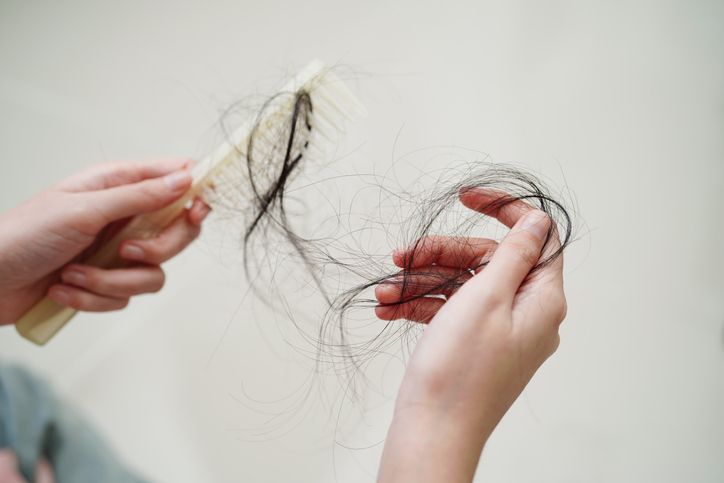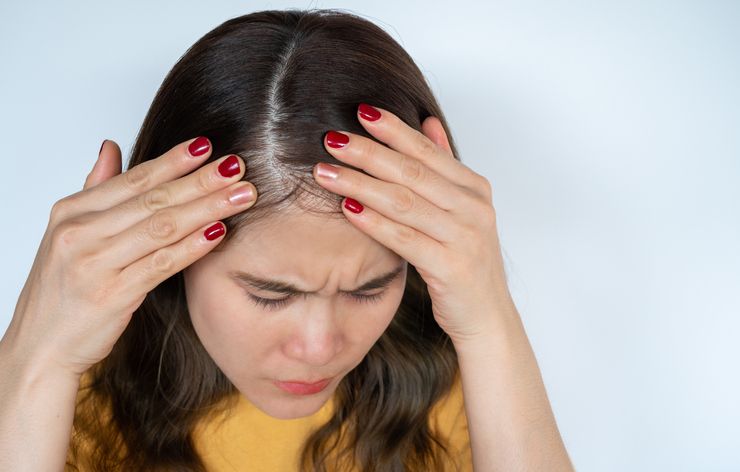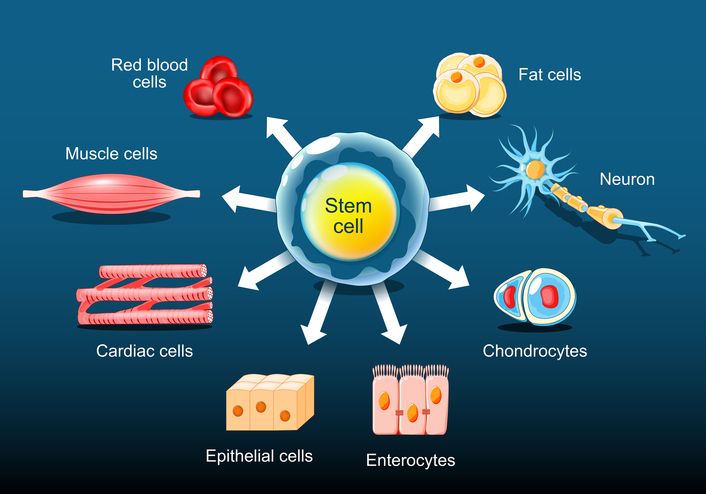

Book Now to Experience
F8 Hair Regrowth Treatment
1 Minute Self-Registration
Date should not be before minimal date
Author: Puteri Fikri|Updated: 23 July 2024
Have you suddenly notice that your hair is not as thick as before? Worry not, find out what is the cause and how you can treat them

1
Get to know what causes hair loss and how you can treat them

Seeing patchy spots or thinning hair can be very heartbreaking to some, especially women who value their hair as the crown to their appearance. Even with the invention of wigs or hair fiber, losing hair can cause low self-esteem. Hair loss is not something that happens abruptly, it will gradually decrease proportional with time. Without proper care and measure, it is possible for you to have noticeable hair loss.
Hair loss can most likely happen to anyone, regardless of their gender and age. Shedding more than 100 strands per day means you are having abnormal hair loss. In general, you should be losing hair around 50 – 100 strands per day due to the normal hair growth cycle. In a process similar to that of the skin, stem cells divide quickly and differentiate into keratinocytes, which migrate, flatten, and eventually die, producing keratinized cells.
Hair follicles
A hair follicle is a pore-like structure that encloses the hair's root and strand. The top two layers of your skin are home to hair follicles. Over 5 million hair follicles are present in your body at birth, and there are over a million on your head. Your hair follicles produce more hair as you become older.
Phases of hair growth
The final hair product that shows on the skin's surface is made completely of keratin. The development of the hair follicle occurs in cycles. The hair shaft goes through phases of rapid growth and extension in between quiescent and regressive stages triggered by apoptotic signals. Three phases—anagen (growth), catagen (transition), and telogen—can be distinguished within this cycle (rest).
The active phase of anagen growth is when the hair follicle assumes its onion-like structure and begins to create the hair fiber. The new hair shaft will appear on the surface of the skin to mark the end of the anagen phase. This phase usually lasts for several years. At any time, the hair that you see on your scalp are in anagen phase. Next, for the catagen phase, it is known as the transition phase which lasts a few weeks.
Hair follicles will shrink and hair growth will slow down. Hair strands will separate from the bottom of the follicles and will eventually detach and fall out. For telogen or resting phase which usually lasts for about 3 months, your hair does not grow but they do not fall out either.
Lastly, the exogen or shedding phase which is the extension of telogen’s stage of hair growth. Washing and brushing will result in hair shedding and this phase can last up to 5 months. After the end of this phase, new hairs are growing in the follicles.


2
Types of hair loss

Hair loss can be observed differently in men and women, especially for their pattern and causes. Although the main problem is hair loss, they can be categorized into many types of hair loss such as androgenic alopecia, alopecia areata, telogen effluvium and scarring alopecia.
Female pattern hair loss
In women, the hair loss can be observed into two main characteristics which are thinning around the hair part or patchy bald spots. As for the female, they usually start with a small amount of thinning around the part and it will start to widen and increase the thinning around it. With the continuous thinning, a see-through area on the scalp can be seen.
Male pattern hair loss
If you can see a single bald spot or receding hairline to form an “M” shape. There are also some cases where the hairline will continue to recede until most of the hair is gone, leaving the upper part of the scalp empty.
Telogen effluvium hair loss
The stress that you are facing during this phase may contribute to hair loss too. Stress impacts the body and hair line which is known as telogen effluvium. Prolonged stress and constricted blood flow can create nutritional deficiencies for the hair follicles. This will cause excessive hair shedding but this condition usually will stop when the person experiences a less stressful event.
Another example of telogen effluvium is the effect from birth control pills which cause the hair to move from growing phase to resting phase a lot sooner than normal. Hair shedding will be in bulk during this phase and if the consumption of the pills stops, the hair loss condition will improve.
Androgenetic alopecia is a common form of hair loss for both genders. They are known as male pattern baldness which thins at the top of the head and progresses to partial or complete baldness. Meanwhile for women, hair falls occur throughout the head and results in overall hair thinning.
Alopecia areata
Although there is presently no cure for alopecia areata, doctors might recommend several forms of treatment to hasten the growth of new hair. This condition can occur almost anywhere on the body, patchy hair loss can be observed on the eyebrows, eyelashes and armpits.
The most popular method of treating alopecia areata is with corticosteroids, potent anti-inflammatory medications that can weaken the immune system. These are typically given orally, topically with ointments, or locally via injections.
Scarring alopecia
A kind of hair loss known as scarring alopecia or cicatricial alopecia, is brought on by the destruction of your hair follicles (shafts on the surface of your skin that hair grows through). Typically, infections, toxins, burns, or autoimmune diseases are at blame. Scarring alopecia can cause permanent hair loss since healthy hair follicles are necessary for hair growth.
Scarring alopecia commonly manifests as an area of baldness where there was formerly hair. There could be one or many bald spots. Skin that once had hair tends to appear smooth and shiny. Alopecia scarring can appear differently on each individual. Additionally, some people have blisters, dry skin, or redness. Permanent hair loss brought on by hair follicle destruction is known as scarring alopecia.
Read More

3
Causes of hair loss

Family history
Family history can be a part of the cause of your hair loss. If you see that your parents experience hair loss either from your mother or father’s side, you may indirectly inherit this condition. Hair loss due to this condition is called androgenic alopecia for male pattern baldness and female pattern baldness. This hair loss will happen gradually along with your age.
Hormonal imbalance
Hair loss can be either permanent or temporary according to their root cause. For hormonal changes like pregnancy, child birth or menopause, the hair loss could be temporary and the hair can be restored after the condition has ended.
Hormonal imbalances can occur in both men and women and can result in hair loss or thinning. Restoring the imbalance frequently encourages hair growth. Although most people associate hormone imbalances with estrogen or testosterone, problems with your thyroid can also cause thinning hair. This condition can be considered temporary hair loss as it will gradually improve after the hormone has been balanced.
Medical conditions
There are certain medical conditions such as alopecia areata that lead to sudden hair loss such as thyroid disorders anemia and polycystic ovary syndrome (PCOS). This condition is normally called telogen effluvium which causes patchy hair loss. Anagen effluvium will involve a rapid loss of hair. For the one who is diagnosed with a serious illness like cancer, they normally will have sudden hair loss due to chemotherapy.
Chemotherapy is a type of treatment that uses radiation therapy to kill the cancer cells with continuous sessions. However, this treatment affects hair loss eventually as it increases hair fall.
Tight hairstyles and harsh chemical treatments
Excessive styling and tight-pulling hairstyles like pigtails and cornrows can result in hair loss called traction alopecia, a type of hair loss. Permanent hair dye and hot oil treatments can both make hair brittle and fall out. Scarring could cause hair loss to become permanent.
Through your selection of hair products and styles, you can be unintentionally contributing to hair thinning. Your hair may start to thin if you use too many harsh products, like gels and sprays, perms, relaxers, and other chemical treatments. Some products may even permanently harm your hair follicles, making it impossible for you to develop new hair in those areas.
High blood pressure
This condition correlates with hair loss in the terms that they will experience gradual thinning. Although it is not definite whether it is the condition or medication that lead to hair loss, several studies confirmed that people with high blood pressure will experience hair loss.
Hair pulling disorder
Trichotillomania, sometimes referred to as trich, is the inability to control the urge to rip off one's hair. They might take off hair from their head or from other areas, such as their lashes or eyebrows.
Trichotillomania signs and symptoms
People who have trich have a strong want to rip their hair out and sense tension building up until they do. After tearing out their hair, they are relieved.
Sometimes a stressful scenario will cause someone to rip their hair out, or they may just do it mindlessly.
What causes trich is not totally known. It might be your coping mechanism for stress or anxiety, or it might be a chemical imbalance comparable to obsessive compulsive disorder in the brain (OCD)
Capitis tinea
Tinea capitis, often known as scalp ringworm, is a fungal infection that can harm the hair shaft and scalp. It results in tiny, scaly, irritating bald spots. If left untreated, the patch or patches will enlarge and fill with pus over time.
Scarring can also result from these spots, which are also referred to as kerions. With antifungal medicine and consistent usage, it is curable. Additional signs include fragile, easily broken hair, scalp sensitivity and rough skin areas that seem red or gray.
Hair loss treatment options
Before your doctor would suggest any treatment, they will do a few tests to ensure what is the root cause of your issue. They may ask a few questions to get to know about your family history or any medical treatments that you are having.
Then, they may suggest for you to do blood tests to know if there are any medical conditions that you are not aware of. Next, the professionals may do scalp biopsy to examine if there is any infection happening on your scalp. For certain clinics, they will use a light microscopy to examine deep into the hair follicles.
Medication
Minoxidil is available over-the-counter (nonprescription) in liquid, foam, and shampoo forms. Apply the product to the scalp skin once daily for ladies and twice daily for males for the best results.
Many people use products containing minoxidil to either regenerate hair, decrease the pace of hair loss, or do both. To stop additional hair loss and to begin hair regrowth, therapy must last at least six months. To determine whether the treatment is effective for you, it can take a few more months.
Oral medications
There are also certain medications that you can consume to slow down hair loss. It is a daily medication that you take with the dosage advice from the doctor. The hair loss of many men using finasteride slows down, and some even report new hair growth.
Early treatment is required if hair loss occurs to anyone. This is because new hair growth will take quite some time and the effect will show after at least several treatments.
Among other daily habits that you can improve to help new hair growth is to get enough sleep. With quality sleep, you will be less stressful throughout the day and excessive shedding can be avoided.
FAQ
What are the most prevalent reasons for hair loss?
Androgenetic alopecia, a genetic disorder that affects both men and women, is the most prevalent cause of hair loss.
Is it possible for stress to induce hair loss?
Stress can cause telogen effluvium, a form of hair loss that is normally transient and resolves on its own.
Is nutrition a factor in hair loss?
Hair loss can be exacerbated by a diet deficient in key nutrients such as protein, iron, and biotin. A healthy diet, on the other hand, may not be enough to prevent hair loss.
Is it possible for certain drugs to induce hair loss?
Indeed, several medications, such as chemotherapy, blood thinners, and antidepressants, can cause hair loss.
Is hair loss more common in male or females?
Men are more typically connected with hair loss, however women can also experience hair loss owing to a variety of factors such as hormonal changes, stress, and genetics.

Book Now to Experience
F8 Hair Regrowth Treatment
1 Minute Self-Registration
Date should not be before minimal date
Recommended Articles
COPYRIGHT© NEW BEAUTY MANAGEMENT LIMITED 2025. ALL RIGHT RESERVED.




